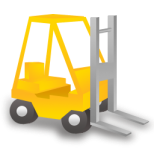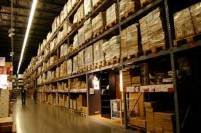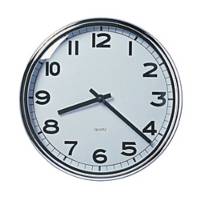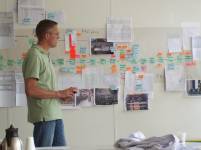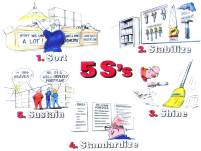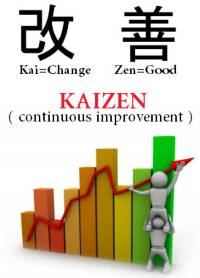Lean Management, the 7 wastes and the Kaizen meaning
Lean Production originates from Toyota. The Toyota Production System is considered world standard with respect to Safety, Quality, Efficiency, Delivery Performance, Cost and Employee Motivation (Morale). The philosophy of this production system is "the complete elimination of all waste" with respect to all aspects of production in order to realize the most efficient methods. Toyota Motor Corporation's vehicle production system is a way of "making things" that is often referred to as "lean manufacturing" or JIT: Just-in-Time. This production system has been established based on many years of continuous improvement, with the objective of "making the vehicles ordered by customers in the quickest and most efficient way, in order to deliver the vehicles as quickly as possible." The Toyota Production System has been based on two concepts: The first is Jidoka ("automation with a human touch") which means that when a problem occurs, the equipment stops immediately, preventing defective products from being produced. The second is JIT or Just-in-Time in which each process produces only what is needed by the next process in a continuous flow. Based on the basic philosophies of jidoka and Just-in-Time, TPS can efficiently and quickly produce vehicles of sound quality, one at a time, that fully satisfy customer requirements. (Part of the text is from the Toyota site).
The Lean 7 wastes called Muda
The Seven Wastes, often referred to as Muda are different types of obstructions of the production flow. These obstructions lead to extra handling or time spent, which however does not add value for the customer. Would you be happy if to pay for a something that was not right the first time or that is not meeting your expectations (for that price)? However, in daily operations we can identify similar issues: activities that are not adding value for the customer; however these activities do add cost.
Why remove Waste?
First of all, you will find that it will have a major impact on your customer satisfaction. Not many people like to wait. Exceeding your customer's expectation is key for a profitable future, because then your customer is likely to return. Secondly, it improves Quality, since all time is actually spent on adding value without any interference from non-value adding activities: extra handling as a rule leads to a lower quality. It improves safety in the workplace: no searching and less walking. Eliminating waste contributes to eliminating unnecessary costs, thus improving profit margins.
The 7 wastes, Muda
We shall briefly describe the 7 Wastes, also referred to as Muda, here. A way to remember the Seven Wastes is TIMWOOD:
1. Transport
2. Inventory
3. Motion
4. Waiting
5. Over production
6. Over processing
7. Defects
Sometimes it is called 8 wastes: not using people's talent to their full extent is then added to the 7 wastes.
1. Transport
Transport should be reduced to a minimum. It is adding cost and increases quality risks. Transportation waste includes the unnecessary movement of information, products or components from one area to another. Unnecessary transport usually occur together with unnecessary movement, product damages, lost parts and leads to extra handling.
Have you ever wondered how much distance a product goes through your factory from entering the site to leaving the site as finished product?
2. Inventory
Every piece of inventory you hold has a cost associated with it, that cost is shouldered directly by yourself either from your cash or from borrowings for which you will be charged interest. Also, inventory leads to extra handling, and in some cases, extra searching. Also the space required to store it, the containers to store it in, the administration of keeping track of it, the damage and losses that occur during transportation, the cost of writing off materials that become obsolete, even the costs of insuring it: they all add up to the cost of inventory.
Have you ever questioned how many inventory you really need and how it could be managed in a more effective way? Do you really need all the inventory you have right now?
3. Motion
Motion is every distance a product, item, tool or person makes to fulfill the required task. It includes lifting, retrieving and moving. In some cases motion and transport are similar, but they are two distinct wastes. It is adding cost and increases quality risks. Motion is handling, and handling means time, resources and risk (product damages etc.).
Have you ever checked how many times a product is touched from entering the site until leaving it? Can this be reduced? Do you have any heavy objects placed on low or high shelves? Do you have to search for tools? Do you have to walk across your work space to retrieve components, consumables or tools? Do you have to turn the product?
4. Waiting
Waiting is a fundamental obstruction to flow, which is a core element from the Toyota Production System. Waiting is the most direct and visible enemy of flow. An important reason for waiting is an unbalanced process, leading to differences in speed.
How often do have to wait for material, information, a colleague? We tend to spend an enormous amount of time waiting for things in our working lives and it inevitably leads to inventory.
5. Over Production
Overproduction arises when more is produced than the customer asked for. This may include both the production of products or components for which there are no orders, as well as production of more items than currently needed. This is important type of waste, because it usually multiplies other kinds of waste. It increases rework rate, inventory, searching, processing, waiting, as well as unnecessary motion and transportation.
6. Over Processing
Over processing is adding work that is not required: it costs money because time is spent on an unnecessary item. It also keeps the operator from spending this time on value adding activities. It includes extra product checks and other types of activities that are not required. It can also mean producing products of a higher quality than required. This may be due to incorrectly used equipment, errors in rework process and/or poor process design.
7. Defects
Defects may lead to scrap. This is a straight forward waste of material, time, resources. On top of that, most industrial waste streams cost money.... Everything not reaching "Right First Time" can be considered a defect. In some case, rework may limit the damage/loss associated with the defect. Rework takes additional resources and therefore increases manufacturing costs of the final product.
Lean Manufacturing, JIT / Just in Time production and Kaizen Event
Here we go more in detail into the steps to achieve Just in Time Production, and the role a Kaizen Event can play here. As stated before, adding value is the key driver for the improvement activities. The explanation primarily focusses on lean 'assembly' production. The philosophy is much wider applicable, including service organizations and administrative departments!
The road towards Just in Time production has the following steps:
1. Awareness, knowing what can be achieved with JIT
2. VSM Value stream mapping and 5S (workplace organization and standardization)
3. Line integration
4. One piece flow, SMED: changeover time reduction
5. Pull system, KANBAN ('pull' instead of 'push')
6. Line balancing
7. Standardization
1. What you can achieve with JIT: Just in Time
The following benchmark figures are available:
Reduction of Work in Progress (WIP) with 70 %
Reduction of throughput time (lead time) with 90 %
Reduction of floor space with 75 %
Additionally, Lean results into significantly improved delivery performance.
2. VSM Value Stream Mapping and 5S
Value stream mapping is a way to map your material and information flow, which facilitates to determine improvement opportunities. The 5S program ensures a well organized, efficient and safe workplace.
3. Line integration
This step realizes the flow concept, which is very important to spot problems instantly. It also eliminates or reduces intermediate stock.
4. One piece flow and SMED
A crucial step to reach your goal: produce on customer demand, the right quantity at the right moment at minimal cost. This also means that change over times are attacked and eliminated. Once this is realised, batch size does not matter anymore, since it does not reduce production efficiency, and therefore a small quantity does not mean extra cost. This already has been achieved in car manufacturing, where batch size now is equal to "one"!
5. Pull system, KANBAN
The next important step: products are not pushed into production anymore (hoping some day they will come out at the other end), but 'pulled' the moment the customer asks for it.
6. Line balancing
The TAKT time (or: 'pulse rate' or 'heartbeat') from the production steps are now balanced.
7. Standardization
To hold the gains, and to continue on the continuous improvement path.
Lean Manufacturing
Lean Manufacturing means to apply this concept, in order to meet your customers demand efficiently and cost effectively.
KAIZEN Meaning
KAIZEN means 'continuous improvement' or "change for the better", in this context most often referred to as KAIZEN Event: a short intensive in house workshop to realize these principles and to demonstrate their power.
What is Takt Time?
One very important aspect is the Takt Time. It plays a crucial role in the concept of waste and waste elimination. Deviations in the process from the takt time result in waste, for example extra inventory. So eliminating waste is about aligning the process with takt time.
Takt time is the average time of customer demand. For example, if a customer wants 10 units per week, then, given a 40-hour work week and steady flow through the production line, the average time between production starts should be 4 hours, yielding 10 units produced per week. A common misconception is that takt time is related to the time it takes to actually make the product: this is not the case. In this example the takt time is 4 hours. Ideally, the takt time equals the interval between the start of production of one unit and the start of production of the next unit. The lead time to produce the product will impact the number of units in production, and therefore the Work in Process, and inventories.
Now it is easier to see that deviations from a 4 hour rhythm inevitably will lead to extra inventory, possibly extra handling, extra space needed to store items etcetera. Takt time is defined by the customer demand, not by production capacities or lead times.

